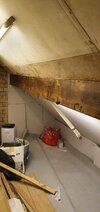Hi everyone,
I have a 1930s chalet bungalow,. Cold drafty house, with issues. Expensive to heat!
Insulation:
1. it has cavity injected insulation.
2. Loft insulation ordinary type 100mm under loft boards and 400mm on none boarded areas, I realise I could put pir under boarded section to improve. I'm considering foil under rafters too to cut down radiant heat - old slate roof no membrane, realise may need vented ridge tiles.
3. I've just finished ground floor putting 100mm pir from crawl space upto floorboards with gaps spray foamed. Intending putting foil type underlay on top of floor boards too under carpets / laminate.
4. I've now started on my bedroom, if has a stud wall (insulated to back), sloping ceilings - no insulation, ceiling (insulated above this with 400mm loft insulation), then down sloping ceiling to almost floor level - none insulated (this area is used as storage behind wardrobes).
I've almost finished insulating all above with 72.5mm insulated plasterboard. See photos.
I'm considering fixing insulated plasterboard to the inside on the external wall ?? As mentioned it has injected cavity wall insulation already, I'm concerned if I don't do it now prior to plastering I'll regret it or could regret if I find it causes damp issues?? If I was to do it what thickness??
I'm going to have a new upvc double glazed window with trickle vent in.
Another thought is to put foil type insulation on top of floorboards - under carpets / laminate, would this cause a problem as it 1st floor stoping heat rising from ground floor, ect????
5. I'm becoming obsessed with it, just had conservatory rebuilt with new windows and solid roof. The front double doors were old leaded glass which are now getting encapsulated into double glazed units. Even considering getting a thermal camera ie flir 1 to identify problems.
6. Please help me figure it all out, I guess the main question is should I add pir insulated plasterboard.to inside of external walls that have previously had cavity wall insulation injected to it???
Kind regards Paul
I have a 1930s chalet bungalow,. Cold drafty house, with issues. Expensive to heat!
Insulation:
1. it has cavity injected insulation.
2. Loft insulation ordinary type 100mm under loft boards and 400mm on none boarded areas, I realise I could put pir under boarded section to improve. I'm considering foil under rafters too to cut down radiant heat - old slate roof no membrane, realise may need vented ridge tiles.
3. I've just finished ground floor putting 100mm pir from crawl space upto floorboards with gaps spray foamed. Intending putting foil type underlay on top of floor boards too under carpets / laminate.
4. I've now started on my bedroom, if has a stud wall (insulated to back), sloping ceilings - no insulation, ceiling (insulated above this with 400mm loft insulation), then down sloping ceiling to almost floor level - none insulated (this area is used as storage behind wardrobes).
I've almost finished insulating all above with 72.5mm insulated plasterboard. See photos.
I'm considering fixing insulated plasterboard to the inside on the external wall ?? As mentioned it has injected cavity wall insulation already, I'm concerned if I don't do it now prior to plastering I'll regret it or could regret if I find it causes damp issues?? If I was to do it what thickness??
I'm going to have a new upvc double glazed window with trickle vent in.
Another thought is to put foil type insulation on top of floorboards - under carpets / laminate, would this cause a problem as it 1st floor stoping heat rising from ground floor, ect????
5. I'm becoming obsessed with it, just had conservatory rebuilt with new windows and solid roof. The front double doors were old leaded glass which are now getting encapsulated into double glazed units. Even considering getting a thermal camera ie flir 1 to identify problems.
6. Please help me figure it all out, I guess the main question is should I add pir insulated plasterboard.to inside of external walls that have previously had cavity wall insulation injected to it???
Kind regards Paul



